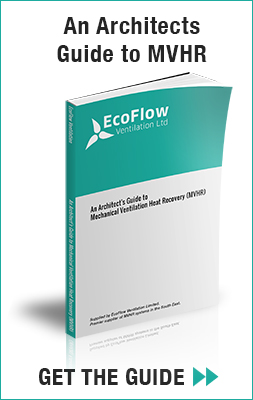You’ve heard about mechanical ventilation heat recovery systems. You’re about to embark on a new build. And you’d like to gain a better knowledge of this fairly new industry before taking steps to specify and design a MVHR system for your building. Here’s our MVHR 101 guide to a revolutionary technology set to improve human health and reduce CO2 emissions as well as cut energy bills to the bone.
What is an MVHR whole house ventilation system?
Mechanical heat recovery technology provides a home with all the warmth and fresh air the people inside need for good health and wellbeing. When specified, designed and fitted properly by experts, they are quiet and efficient, improving indoor air quality, cutting down dust and removing nasty allergens.
Mechanical ventilation systems and your health
New homes are fantastically well insulated, with very little air leakage. It’s a good thing because it means new builds are so much more energy-efficient. But on the down si, excellent insulation means airtightness, which in turn leads to serious ventilation and condensation issues. Yes, the warmth is kept in… but at the same time fresh air is kept out and indoor pollutants never escape. Worse still, modern window trickle vents only deliver a tiny amount of air exchange.
UK air ventilation system legislation
UK government legislation and building regulations mean builders, architects, self-builders and developers are having to tackle the issue for every new build, which increasingly means installing mechanical ventilation with heat recovery, or MVHR. The technology provides year-round, whole home ventilation that removes moisture and pollutants from the home to improve the indoor air quality, at the same time recovering precious heat that would otherwise be wasted.
The rise and rise of heat exchange ventilation
MVHR is enjoying a surge in popularity as a result of all this, together with high energy bills that look unlikely to come down and essential ‘green’ initiatives. It’s becoming more and more popular because of its proven low-energy, highly efficient ventilation, which works by combining air supply and air extraction in one simple unit.
How does a MVHR house ventilation system work?
Damp, stale air is extracted from so-called ‘wet’ areas like kitchens and bathrooms, where there tends to be a lot of moisture and warmth in the air. The heat from the dirty air is recovered by the system’s clever heat exchanger, which then delivers the fresh, cleaned air back into the home’s living areas: the bedrooms, living rooms, dining rooms and so on.
Complying with the regulations
An MVHR system will help you to achieve a high SAP Q score and also complies with Part F building regulations.
What is SAP?
SAP is the government’s Standard Assessment Procedure for Energy Rating of Dwellings, used to pin down compliance for homes under Part F of the building regulations. It also provides energy ratings. It’s the Department of Energy and Climate Control’s way of assessing and comparing the energy performance and environmental impact of a house, and it underpins the nation’s energy and environmental policies.
SAP 2005 Appendix Q evaluates the energy performance of new technologies and advanced versions of existing technologies within SAP. It includes solar air preheat positive input ventilation, mechanical extract ventilation and balanced whole house mechanical ventilation.
Building Regulations Part F
Part F of the UK’s building regulations deals with ensuring that adequate means of ventilation is provided for people in the building, ventilation being the removal of ‘stale’ air from a building and replacement with ‘fresh’ air from outdoors. The primary objective is to condition the air at a comfortable, safe level while protecting the fabric of the building, and MVHR does an excellent job of it.
The benefits of Mechanical Ventilation Heat Recovery technology
The systems come with many benefits, including:
- Very low noise levels when installed properly
- Suits all property sizes and types
- Saves space, compact and lightweight
- Saves money via very low running costs and efficient heat recovery
- Simple to install (as long as you know what you’re doing!)
- Fan controls for fast, simple
- Some systems come with summer bypass and integral frost protection
- Low maintenance
- No-tools-required, easy-access filters
- Future proof and environmentally friendly
- Great for your health
Want to know more?
Our designers are fully qualified Code for Sustainable Homes Assessors and SAP assessors,which means we completely understand the requirements. Why not check out the rest of our blog, or contact us to talk through your new build project?





Leave A Comment